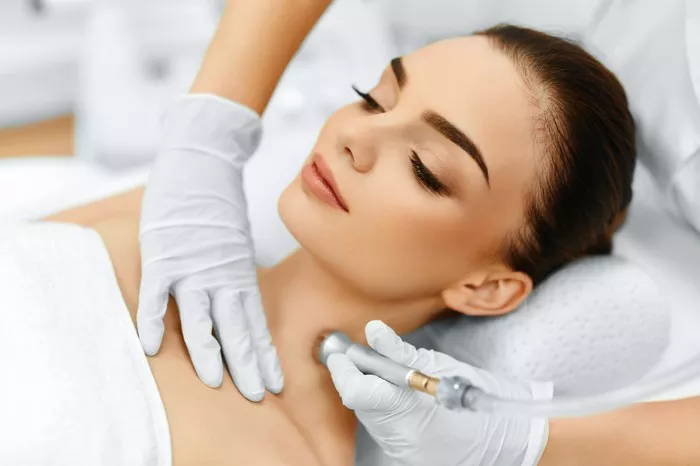In the realm of advanced skincare, the combination of microdermabrasion and chemical peels has emerged as a powerful duo, offering individuals the potential for enhanced skin renewal. Understanding the science behind each procedure and the considerations for their combined use is essential for those seeking comprehensive skincare solutions. In this comprehensive guide, we explore the dynamic interplay between microdermabrasion and chemical peels, shedding light on their individual benefits and the potential synergy when incorporated into a holistic skincare regimen.
Understanding Microdermabrasion
Defining Microdermabrasion:
Microdermabrasion is a non-invasive exfoliation technique designed to improve skin texture, tone, and overall appearance. This procedure involves the use of a handheld device that exfoliates the outermost layer of the skin, revealing smoother and rejuvenated skin beneath.
Mechanism of Action: Abrasion and Vacuum Suction:
Microdermabrasion employs fine crystals or a diamond-tipped wand to abrade the skin gently. Simultaneously, a vacuum suction mechanism removes the exfoliated skin cells, promoting circulation and stimulating the skin’s natural renewal process.
The Science Behind Chemical Peels
Defining Chemical Peels:
Chemical peels are cosmetic treatments that utilize various chemical solutions to exfoliate the skin’s outer layers. These solutions, which may include acids such as glycolic acid, salicylic acid, or trichloroacetic acid (TCA), are applied to the skin to induce controlled exfoliation.
Depth of Peels:
Chemical peels are categorized based on their depth of penetration. Superficial peels target the outermost layer (epidermis), medium peels reach the middle layer (dermis), and deep peels penetrate to the deeper layers of the dermis. The choice of peel depends on the desired results and individual skin concerns.
Can Microdermabrasion and Chemical Peels Coexist?
Sequential vs. Combined Approaches:
The use of microdermabrasion and chemical peels can be approached sequentially or in combination. Some practitioners advocate for a sequential approach, where one treatment follows the other, while others support a combined approach, integrating both techniques into a single session.
Sequential Use:
In a sequential approach, microdermabrasion is often performed before a chemical peel. Microdermabrasion primes the skin by removing surface debris and promoting a more even penetration of the chemical peel solution. This sequential method is considered safe and effective.
Benefits of Combining Microdermabrasion and Chemical Peels
Enhanced Penetration:
Microdermabrasion serves as an effective primer for chemical peels. By removing the outer layer of dead skin cells, microdermabrasion allows for better penetration of the chemical peel solution, maximizing its efficacy and promoting a more uniform result.
Synergistic Exfoliation:
The combination of microdermabrasion and chemical peels offers a synergistic exfoliation. Microdermabrasion targets the superficial layers, while chemical peels delve deeper, collectively addressing a broader range of skin concerns and promoting a smoother complexion.
Considerations for Combined Use
Skin Types and Sensitivities:
The combined use of microdermabrasion and chemical peels requires careful consideration of individual skin types and sensitivities. Not all skin types may be suitable for aggressive combined treatments, emphasizing the importance of personalized assessment.
Adjusting Intensity:
For individuals with sensitive skin or those new to combined treatments, a gradual introduction is recommended. Lower intensity microdermabrasion and superficial chemical peels can be a starting point, with adjustments made based on the skin’s response.
Potential Side Effects and Risks
Redness and Sensitivity:
Both microdermabrasion and chemical peels may cause temporary redness, sensitivity, and mild discomfort immediately after treatment. These effects typically subside within a few hours to a day, but sunscreen and gentle skincare are advised for post-treatment care.
Risk of Over-Exfoliation:
The risk of over-exfoliation exists when combining these treatments. Careful monitoring of the skin’s response, adherence to recommended intervals between sessions, and adjusting the intensity based on individual tolerance are crucial for minimizing risks.
Post-Treatment Care
Hydration and Sun Protection:
Following combined microdermabrasion and chemical peels, hydration and sun protection are paramount. Moisturizing the skin supports recovery, while diligent use of sunscreen shields the renewed skin from UV damage, preventing pigmentation issues and maintaining results.
Avoiding Harsh Products:
In the post-treatment period, it is advisable to avoid harsh skincare products that may irritate the skin. A gentle skincare regimen, featuring mild cleansers and soothing moisturizers, supports the skin’s healing process.
Patient Education and Informed Consent
Open Communication: Setting Expectations:
Patient education and open communication are essential aspects of the combined use of microdermabrasion and chemical peels. Setting realistic expectations, discussing potential side effects, and ensuring informed consent contribute to a positive patient experience.
Patch Testing and Sensitivity Assessment:
Conducting patch tests and assessing skin sensitivity before initiating combined treatments enhance safety. These measures allow practitioners to identify potential adverse reactions and tailor the treatment plan to the patient’s individual needs.
Conclusion
In conclusion, the interplay between microdermabrasion and chemical peels exemplifies the power of synergy in advanced skincare. Whether approached sequentially or in combination, these treatments offer a dynamic solution for individuals seeking enhanced skin renewal. Careful patient selection, consideration of skin types, and diligent post-treatment care contribute to a positive and efficacious experience. By harnessing the strengths of both microdermabrasion and chemical peels, skincare practitioners can tailor comprehensive treatments that unlock the potential for rejuvenated and radiant skin.

